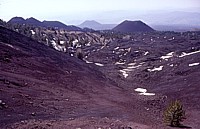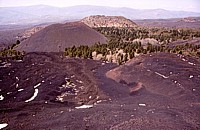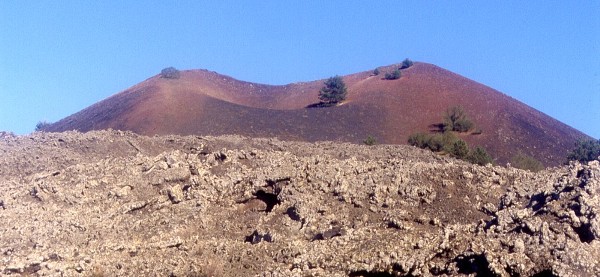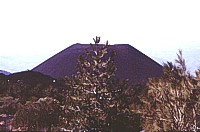| Etna
index |
||
| Geology | Geological history | Cones and craters |
| Eruptive characteristics | Eruptions before 1971 | Eruptions since 1971 |
| Etna and Man | References | Web sites |
| Weather forecasts | FAQ | Latest news |
Mamma
Etna's countless children
Monte Nuovo (1763 eruption)
W flank, 14.89977° E, 37.73787° N
Summit elevation: 1674 m
![]()
To
the inhabitants of the western flank of Etna, during the 18th century,
the growth of a new pyroclastic cone was certainly an impressive experience.
In February-March 1763, the first historically documented birth of a new
cone on that side of the volcano occurred in an area between Monte
Lepre and Monte Rosso, and the newly
formed cone was named "the new mountain" - Monte Nuovo. Only
four months later, yet another new mountain formed during a second flank
eruption, this time on the south flank of Etna. The cone formed during
that event became known as Montagnola.
Monte Nuovo is a beautifully shaped, essentially unvegetated cone whose
conspicuous reddish color makes it appear in marked contrast with the
surrounding older, and more or less densely vegetated cones, and the much
more recent black cones of the Monti De Fiore,
formed in early 1974. Rising about 80 m above
its SW base, Monte Nuovo bears a few pioneer pine trees, one of which
has grown in the relatively protected (from wind), small summit crater
that is only about 90 m wide. A notch opens the crater rim on its western
(downslope) side, where smaller vents were probably active along a short
fissure, which in its lower portion contains the main effusive vent from
which a 3.7 km long lava flow issued. This flow flowed around the southern
side of Monte Ruvolo and still bears very
little vegetation (mainly lichens with a few scattered bushes).
In mid-October 2002 I had the doubtful privilege to walk about 1 km across
this lava field, which was about as bad as walking across very recent
lavas. On that occasion I passed at the western base of the cone but time
limits prevented me from climbing it. The photos shown on this page were
taken mostly during a 1997 visit to the nearby Monti
De Fiore and during the close passage of October 2002.
 |
 |
|
Left:
in this panoramic view from the summit of Monte
Mezzaluna, Monte Nuovo is seen as a symmetrical cone in the
right center, at a distance of about 1 km. Further to the left lie
the two cones of the Monti Di Fiore,
formed in January-March 1974, and the
enormous cone of Monte Minardo is
seen in the distance. Photo taken in April 1997 Center: the symmetrical shape of Monte Nuovo is evident in this photograph taken from the east in April 1997 Right: Monte Nuovo seen from the summit of Monte Di Fiore I in April 1997. Lavas seen in the foreground were produced during the first phase of the 1974 Monti Di Fiore eruption. In the background lies Monte Lepre, which probably erupted in Medieval time |
||
Copyright © Boris Behncke, "Italy's Volcanoes: The Cradle of Volcanology"
Page set up on 15 December 2003, last modified on 21 February 2004


